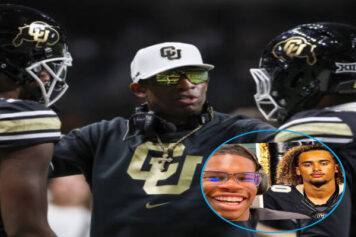On this day in 1964, The Civil Rights Act was passed by the Senate, and eventually signed in to law by President Lyndon B. Johnson on July 2nd of that year with Dr. Martin Luther King Jr. in attendance. The act was described as the single most important civil rights legislation since the Reconstruction era by CNN. It prohibited discrimination on the basis of race, color, religion, sex and national origin and was followed by other legislation like The Voting Rights Act and The Fair Housing Act within the next four years. Though many of us would certainly struggle to correlate this act with the advancements made by minorities in sports, many followers of The Shadow League can readily recall the exploits of the great Jackie Robinson and how he broke the color line in Major League Baseball; others will recall that Sweetwater Clifton and Earl Lloyd were the first black players signed and drafted, respectively, in the National Basketball Association, and others still will remember that Charlie Folis was the first player of African-American descent to be selected in the NFL draft. But what then?
Though there are some novice historians out there who could easily recall the firsts enjoyed by players, coaches and managers of all ethnic groups, the road that has been traveled to get from “there” to “here” has been long and arduous and much of the progress that has been made in all of professional sports can be traced back to the Civil Rights Act that was signed by LBJ 50 years ago. However, we would be remise if we didn’t mention the fact that there has been other civil rights legislation prior to 1964. In fact, the very first civil rights act was signed in 1866, with another one following it in 1875, but the latter act was struck down by Congress. There was yet another civil rights act in 1957. The fact that there have been multiple acts with the same name signed by various presidents over the history of the nation can speak of both negatively and positively of our Great Nation. The ebbs and flows of tolerance in these various timeframes appear to have been capped off by these various civil rights acts and, with each instance, we see this reflected in various sporting leagues and sporting events of yesterday and today.
Around the time of the Civil Rights Act of 1875, horse racing was one of the most popular sports in America. It was also a sport that was dominated by the descendants of former slaves; in fact, African-American jockeys won 15 of the first 28 Kentucky Derbies and Isaac Murphy was the most famous of them all. He won 628 of 1,412 mounts in his career. The last black jockey to win the Preakness was Willie Simms in 1898. He is also the only jockey ever have won all the Triple Crown races. It would appear that black jockeys were able to take advantage of opportunities afforded to them by the Reconstruction Era (1865-1877) as well as the Civil Rights Act of 1875 and the Fourteenth Amendment of 1868. Around the same time segregationist Jim Crow laws were springing up throughout the South and these racist attitudes would seep into the participation in professional sports as well; however, with the introduction of big money, out went the dominance of black jockey, and most had left the sport by the 1920s. As with many political movements, civil rights for blacks in America are often seasonal as support for the inclusion of minorities in all areas of society, and are largely dependent upon society’s willingness to side with what’s right rather than with what’s comfortable.
Conversely, early politics of racial exclusion in America were not an anomaly and were largely reflective of the racist attitudes of the majority during that time. There would not be any significant civil rights legislation in the U.S. between 1875 and the Civil Rights Act of 1964, but there were still many instances where society, and not the government, would lead the way. John Taylor would become the first black citizen to compete for the United States in international competition in 1906 and would win an Olympic gold medal in the 1600-meter medley relay at the 1908 London Olympics while running the 400 meter leg of the race. Fritz Pollard would compete in college football for Brown University, joining Paul Roberson of Rutgers in breaking the color barrier at major colleges.
Despite not being able to shower, travel or dress with his team, Pollard would dominate his competitors and go on to become the first African-American to be named to the Walter Camp All-America list. Fritz would play for the Akron Pros in 1920 but there would be few professional football opportunities for African Americans, and no team had a black player by 1932. It wasn’t until 1948, when the powerful benefactor Branch Rickey of the Brooklyn Dodgers signed the great Jackie Robinson, that the color line was broken in professional baseball. Sweetwater Clifton followed by becoming the first black player sign an NBA contract in 1951. These ground breaking acts demonstrated that sports would lead society’s acceptance of African-Americans between legislation against discrimination, but there were several landmark decisions and court cases that reflected society’s willingness to advance the case of greater societal inclusion for all racial and ethnic minorities
Despite overtures being made across professional sports to include African-Americans, women and girls who wanted to participate in sports at the high school and collegiate levels had to wait until the 70s; that’s when Title IX was introduced. This federal law is a portion of the Educational Amendments of 1972. It states that No person in the United States shall, on basis of sex, be excluded from participation in, be denied benefits of, or be subjected to discrimination under any educational program or activity receiving federal financial assistance.
At the 50th anniversary of the Civil Rights Act we find there are other battles looming in America and a direct correlation between sports and society’s willingness to except change. The stalling of President Barack Obama’s move to draft an Executive Order on LGBT job discrimination makes one wonder just how far we’ve come on this historic day. Yet last season Jason Collins, currently of the New Jersey Nets, came out as the first active gay male athlete in professional sports. Current St. Louis Rams draftee Michael Sam recently became the first openly gay active NFL player while University of Massachusetts basketball player Derrick Gordon came out as well. Most recently, the world was shocked at the release of the comments made by Donald Sterling, illustrating to the world that the “good old boy” network of the corporate boardroom still exists, even in a sport that is majority African American. On this historic day we must acknowledge and celebrate the progress that has been made; from the events above, to Adam Silver's swift reaction to Sterling's comments, Doc Rivers being named as President of Basketball Operations of the Los Angeles Clippers and, just two days ago, the US Patent and Trademark Office's decision to revoke the trademark rights of the Washington Redskins franchise. These events demonstrate the progress made in the struggle for civil rights in the sports arena, giving hope to the overall fight happening every day.
As was the case with the various civil rights acts coinciding with societal willingness, or lack thereof, to accept African-American players, and the passing of Title IX coinciding with the rise of the feminist movement, we may be on the verge of witnessing a change in the way society views others who are fighting for equality. Will professional and collegiate sports follow society on this issue or vice versa? Only time will tell.
But like a quest to win a championship, the struggle for civil rights continues.



